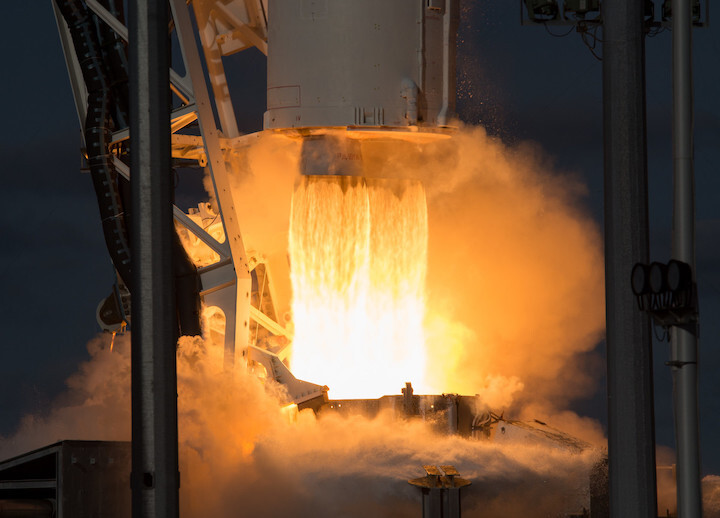13.05.2022

Northrop Grumman says it has a backup plan to fulfill the company’s contract to resupply to the International Space Station if the war in Ukraine continues to disrupt the supply of Russian engines and Ukrainian booster cores for the company’s Antares rocket.
The company has hardware in its inventory for two more Antares resupply launches — currently scheduled for August and early 2023 — but needs engines and booster tanks imported from Russia and Ukraine for additional Antares flights.
NASA announced in March an award to Northrop Grumman for six additional cargo missions to the International Space Station, beyond the next two Antares flights already under contract. Northrop Grumman has launched 17 cargo missions to the space station using the company’s Cygnus supply freighter under the umbrella of two Commercial Resupply Services contracts, with eight more Cygnus flights now on the books.
Kathy Warden, Northrop Grumman’s president and CEO, said in an April 28 earnings call that the company has “some exposure” to the fallout from the war in Ukraine on the NASA resupply contract.
“We have what we need for the next two launches,” Warden said. “So there isn’t immediate disruption, and we have a plan in place that we could use other sources if needed, beyond those two launches.”
Warden did not discuss the backup options available to Northrop Grumman, but the company has launched Cygnus cargo missions on United Launch Alliance’s Atlas 5 rocket in the past. A company spokesperson declined to offer additional comments beyond Warden’s remarks.
“It’s our preference to keep the relationship intact between Russia and the U.S. around the space station, and that’s what these rocket motors are used for — to take cargo to the International Space Station,” Warden said. “But we are working closely with NASA to make sure we’re following the U.S. government lead in that case.”
The Biden administration has limited imports of Russian products to the United States, but the order’s impact on a critical civilian space program — like the resupply of the space station — is unclear. Dmitry Rogozin, head of Russia’s space agency, said in March that Russia was halting the export of rocket engines to the United States.
ULAs Atlas 5 rocket, used for U.S. military and commercial satellite launches, is powered by a dual-nozzle Russian RD-180 main engine. But ULA says it has received all the RD-180 engines it needs for the remaining 24 Atlas 5 flights until the rocket’s retirement in favor of the next-generation Vulcan launch vehicle, with all U.S. engines.
The Antares rocket uses engines from the same family as the RD-180. The Antares first stage is powered by two single-chamber RD-181 engines.
The RD-180 and RD-181 engines are produced by NPO Energomash in Khimki, Russia. The Antares core stage is built by Yuzhmash in Dnipro, Ukraine.
“The primary means of launching Cygnus is on the Antares rocket,” said Sandra Jones, a NASA spokesperson. “Northrop Grumman does have flexibility to launch Cygnus on a different launch vehicle and has done so in the past. Any changes from Antares to a different launch vehicle would be worked closely between NASA and NG.”
All of ULA’s Atlas 5 rockets are sold to customers. ULA’s new Vulcan rocket and SpaceX’s Falcon 9 rocket are the only other U.S. vehicles in operation, or soon to debut, with the lift capability to haul a Northrop Grumman Cygnus supply ship into orbit.
Orbital ATK, which was acquired by Northrop Grumman in 2018, has already redesigned the Antares rocket to accommodate a new type of engine. The company selected the RD-181 engine to replace the AJ26 engine, also built in Russia, after an investigation concluded the AJ26 was responsible for the explosion of an Antares rocket seconds after liftoff in 2014.
The RD-180 and RD-181 engines have never failed in flight on Antares or Atlas 5 rockets.
SpaceX and Sierra Space, formerly Sierra Nevada Corp., are NASA’s other two cargo transportation providers for the space station. SpaceX has launched 24 cargo missions to the space station using its Dragon spacecraft and Falcon 9 rocket, while Sierra Nevada is developing the Dream Chaser space plane to launch on ULA’s Vulcan rocket next year.
NASA awarded SpaceX a contract extension for six additional Dragon cargo missions earlier this year, at the same time the agency ordered six more Cygnus flights from Northrop Grumman.
Sierra Space has three Dream Chaser cargo missions on contract with NASA.
Quelle: SN
